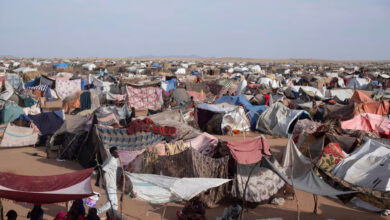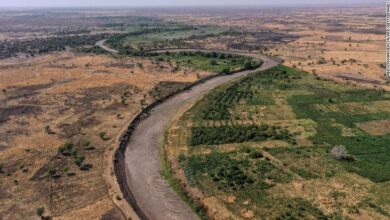Understanding the complexities of Juba’s political past and present is nearly as tricky as navigating its streets. In the second installment of his two-part story on Southern Sudan, Mohamed El Dahshan travels the city’s roads and modern history, and shares thoughts on Egypt’s political relations with Sudan.
“Boda-boda?” (“motorcycle-taxi?”) asked a young man, standing across from a fortified United Nations compound in Juba, where I was consulting my notes.
I blinked in disbelief–the man was missing an eye. I briefly wondered whether he was even allowed to ride a motorbike with only one good eye, before reminding myself that security regulations aren’t applied particularly rigorously here anyway. I mumbled, “No, thank you,” and went back to my notes.
A staple of East African cities, the boda-boda is Juba’s primary and most rapid means of public transportation. On a given day, a boda-boda braves the mostly dirt roads, the multitude of Range Rovers with international organizations’ license plates, and the construction sites marking every other street corner. Minibuses with (more or less) set prices also ride along the main axes of the city.
If Juba has a survivor’s spirit, then so will I, I decided, even if that meant riding with a half-blind driver. I turned back to where he stood chatting with some fellow boda-boda drivers, smiled, and pointed at the motorbike. “New Customs market?” I asked.
Francis, then, would be my driver for the day. From pavement to dirt, madly dodging traffic and pedestrians, we crisscrossed Juba’s maze of roads.
“The government in Khartoum has only paved the roads leading to the north to encourage trade between Khartoum and Juba, and disregarded the roads from Juba to Uganda and Kenya,” says Robert Ohia, a 29-year old Southern Sudanese translator and master’s degree student who has studied in Khartoum. He regularly travels between the two cities.
This is partially true; the central government has indeed endeavored to link the country’s two halves to foster economic relations, but paved roads from Khartoum southward only reach halfway to Juba. Currently, road development planners are more concerned with linking Juba to other main towns in Southern Sudan, as well as to Kenya and Uganda. It’s these places, as you’re bound to notice after half a day in Juba, that are Southern Sudan’s natural neighbors; Khartoum couldn’t feel further away.
The New Customs market, where Francis took me, is Juba’s largest, and has recently been relocated to the outside of town. Rows of metal shacks dabble in new and used goods, selling everything from Uganda’s finest kitchenware to the now-famous OBAMA t-shirt: “Originally Born in Africa to Manage Americans.” I couldn’t find an OBAMA t-shirt in my size, so instead I bought a shirt featuring the late politician and rebel leader John Garang. Beneath his picture were the words: “New Sudan.”
Ah, the irony. John Garang de Mabior was a Sudanese Army Colonel who, when sent by Khartoum to negotiate with rebels, joined the rebellion himself. Garang led the war, aiming for what he called a “New Sudan”–a federal, united state with greater rights for the Southern Sudanese.
He secured the overwhelmingly favorable Comprehensive Peace Agreement (CPA), which was forcefully supported by his chief allies, the United States and the Intergovernmental Authority on Development (IGAD) countries. The terms of the agreement included a provision for the southerners to vote on self-determination after six years, while taking steps to make unity a more attractive option for voters.
In 2005, after a mere three weeks as Sudan’s Vice President, Garang was killed in a helicopter accident, and his New Sudan policy died along with him. His successor, Salva Kiir, supports the separation of the South, and with the referendum only months away, there are few doubts that a new country will be voted into being.
Buried in Juba, Garang’s mausoleum is probably the only remotely touristic “attraction” in the city. The bathroom ceramic tiles and plastic flowers significantly take away from the awe of the place, however.
Another Juba market worth visiting is Konyo-Konyo. Located by the southern end of the city, with a fantastic view of the Nile (if you take photos, be careful; if caught, you’ll be held and your photos deleted) it is run mostly by Ugandan traders, whose trucks can be seen constantly racing the Juba-Kampala axis.
The Southern Sudanese–based on an admittedly limited sample of people I approached–may not be openly hostile toward Egypt, but they do express little sympathy for us. Cairo’s strategic partnership with Khartoum is viewed with mistrust.
The Egyptian consulate in Juba (unlike most other countries, with only a representative bureau or a chargé d’affaires, Egypt has a full-fledged consulate) is a downtown villa outfitted with a comically large flag. It has seemingly very limited relations with the population.
The Egyptian clinic, however, is probably Egypt’s chief form of public diplomacy in South Sudan. Manned by skilled and lauded Egyptian doctors who offer their services for a low price, it is a landmark in the northeastern section of the city.




